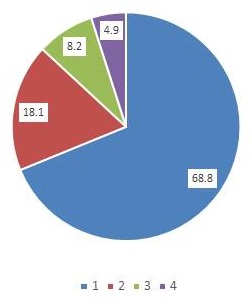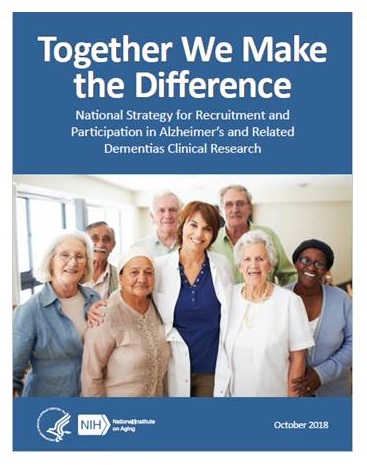Friday, October 19, 2018
Printer Friendly Version in PDF Format (11 PDF pages)
Together We Make the Difference National Strategy for Recruitment and Participation in Alzheimer's & Related Dementias Clinical Research
Marie A. Bernard, MD
Deputy Director, National Institute on Aging
National Institutes of Health
Urgent mission
- National Alzheimer's Plan goal 1: "To effectively treat or prevent Alzheimer's by 2025"
- Public funding is increasing, research is accelerating
- Drugs and other interventions in rapid development, moving to clinical trials to be tested
- 200+ trials currently underway, seeking 100,000+ participants
- The number of people with Alzheimer's disease is rapidly growing
- 2018 = 5.5 million; 2050 = 13.8 million
- More than 200 Alzheimer's and related clinical trials in the U.S. need at least
- 100,000 people with Alzheimer's, healthy volunteers, and caregivers. However, recruitment and retention of diverse participants is a challenge.
But, more studies competing for volunteers
- Many research sites are slow to meet volunteer recruitment targets, while others do not reach their targets at all
- Delays in time to complete studies
- Increases research costs
- Precision medicine -- right treatment, right person, right time -- means representation of all is critical
Recruitment challenges for AD/ADRD studies
- Participant burden:
- Study partner requirements
- Invasive and time-consuming procedures
- Strict eligibility criteria
- Lack of capacity, awareness, and resources among primary care physicians
- Need for cognitively unimpaired volunteers
NIA analysis of inclusion in AD/ADRD trials
- Older adults are included
- Representation of non-white populations is variable
- Trial exclusion criteria may negatively impact participation of underrepresented groups:
- Multiple medications
- Neurological, cardiovascular, diabetes, cancer, other co-morbidities
| % by Race of participants in NIH-funded AD trial publications |
|---|
 |
Overcoming challenges, opening doors
- What is NIA doing in collaboration with others to overcome inclusion and recruitment challenges?
- Developing national recruitment strategy
- Funding opportunities and infrastructure
- Outreach and education
- Will require a wide variety of stakeholders: industry, clinicians, public, researchers, advocates
National Strategy for Recruitment and Participation in Alzheimer's & Related Dementias Research
- GOAL:
- Engage broad segments of the public in Alzheimer's and related dementias research
- Focus on underrepresented communities
- Assist studies in successfully and more quickly enrolling and retaining people in studies to better understand and eventually cure these disorders.
 |
| https://www.nia.nih.gov/ research/recruitment-strategy |
4 areas of focus
- Increase awareness and engagement
- Build and improve infrastructure
- Engage local communities and support participants
- Develop an applied science of recruitment
1. Increase Awareness and Engagement
- Strategic Priorities:
- Identify diverse audiences needing tailored messages and best locations and modes of outreach at the national and community levels.
- Develop and disseminate culturally and linguistically appropriate content for outreach and awareness.
2. Build and Improve Infrastructure
- Strategic Priorities:
- Leverage and improve existing registry infrastructure.
- Develop and adapt information technologies to support recruitment.
- Structure staffing and organizational incentives to support and reward successful recruitment.
- Support study site capacity building.
- Improve efficiency and effectiveness of screening.
- Facilitate collaborative networks of study sites.
3. Engage Local Communities & Support Participants
- Strategic Priorities:
- Develop equitable and sustainable community partnerships to build trust and shared ownership of research mission.
- Promote health and science literacy in the community with a focus on cognitive health.
- Expand trial design to encourage participation of more diverse communities.
- Facilitate diverse participation by providing support and audience-specific recruitment and retention strategies.
- Identify and prioritize available resources to develop community partnerships and support participants.
4. Develop an Applied Science of Recruitment
- Strategic Priorities:
- Develop baseline measures and evaluate and optimize effectiveness of outreach and recruitment strategies.
- Create, disseminate, and continuously improve evidence-based recruitment resources.
Roles for Stakeholders -- Gov Agencies
- Signal priorities in funding opportunity announcements or procedures
- Shape application submission and review requirements
- Work directly with investigators in cooperative agreements
- Collect and disseminate evidence-based resources in a central location
- Support evaluation efforts and compilation of the evidence base
- Provide a national voice to communicate priorities
Roles for Stakeholders -- Advocacy Organizations
- Organize national, regional, and local awareness campaigns
- Build and maintain relationships with other stakeholder groups
- Create and adapt materials and resources for study site use
- Collect and disseminate evidence-based resources
- Support or conduct community needs assessments and evaluations
- Provide a national voice to communicate and reinforce priorities.
Roles for Stakeholders -- Researchers, Study Sites, Institutions
- Plan and budget for the priorities outlined in the Strategy
- Prioritize and implement improvements in study site capacity and workforce to support diverse recruitment
- Develop local-level community partnerships, build trust, involve community in the research enterprise
- Develop referral networks with primary care providers and other study sites
- Implement trial designs and organizational incentive structures that maximize diverse participation.
Roles for Stakeholders -- Community Orgs
- Participate in community advisory boards
- Build relationships with researchers and study sites
- Host community events or offer locations for study outreach
- Become involved in the research enterprise
Roles for Stakeholders -- People with Dementia, Caregivers, Families
- Share their experiences with others
- Ask primary care physicians for screening or referrals to clinical research opportunities
- Participate in clinical research
- Become peer mentors for others considering research participation
- Provide input and feedback to researchers and study sites
- Help study sites build community partnerships
NIA's Role in Implementation
- Convene and facilitate
- Continue to convene and facilitate stakeholders to implement tactics outlined in the National Strategy
- Targeted outreach
- Continue to increase awareness, conduct targeted outreach efforts
- Enhance and share the evidence base
- Support evaluation of and disseminate research on effective recruitment strategies
- Funding and policy
- Address recruitment challenges through funding initiatives and policies Support research infrastructure enhancements
Funding opportunity for community engagement
- Examining Diversity, Recruitment and Retention in Aging Research (PAR-18-749) https://grants.nih.gov/grants/guide/pa-files/PAR-18-749.html
- Encourages building new, collaborative teams to target gaps in recruitment and retention methods and outcomes
- Support for establishing community infrastructure needed to accelerate studies
- Read more at: https://www.nia.nih.gov/ research/blog/2018/05/ team-accelerate-recruitment-aging-research
Social Media Outreach
Join us on Twitter Tuesday October 23 to celebrate #ResearchDiversity
 |
We've only just begun... We're all in this together
What can each of us do to move Alzheimer's & related dementias research forward?
